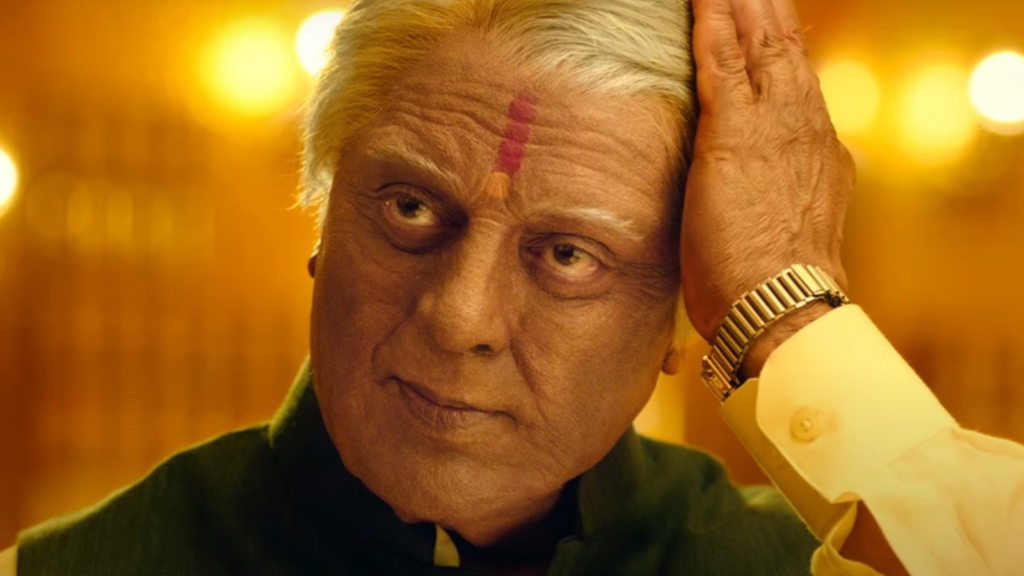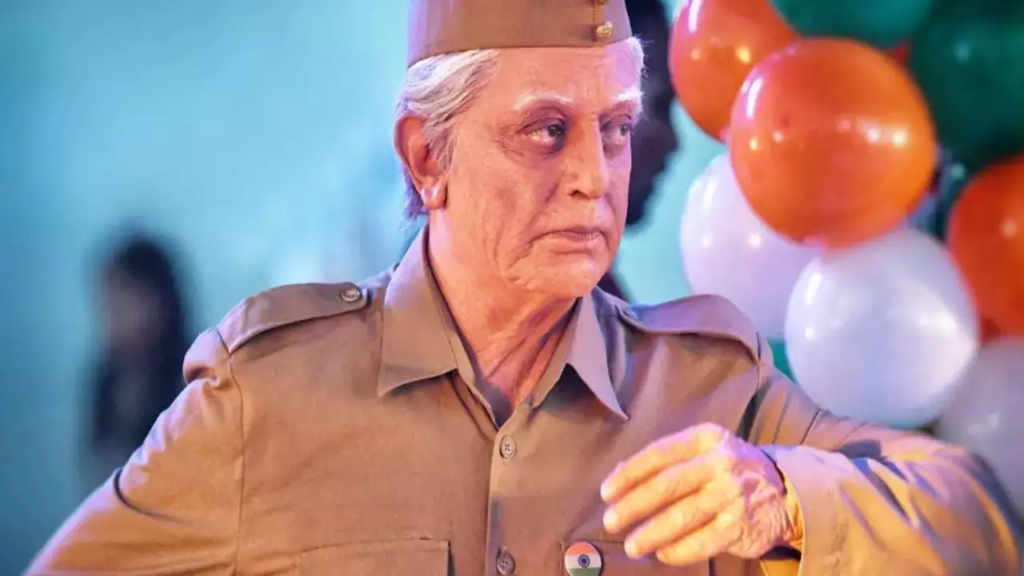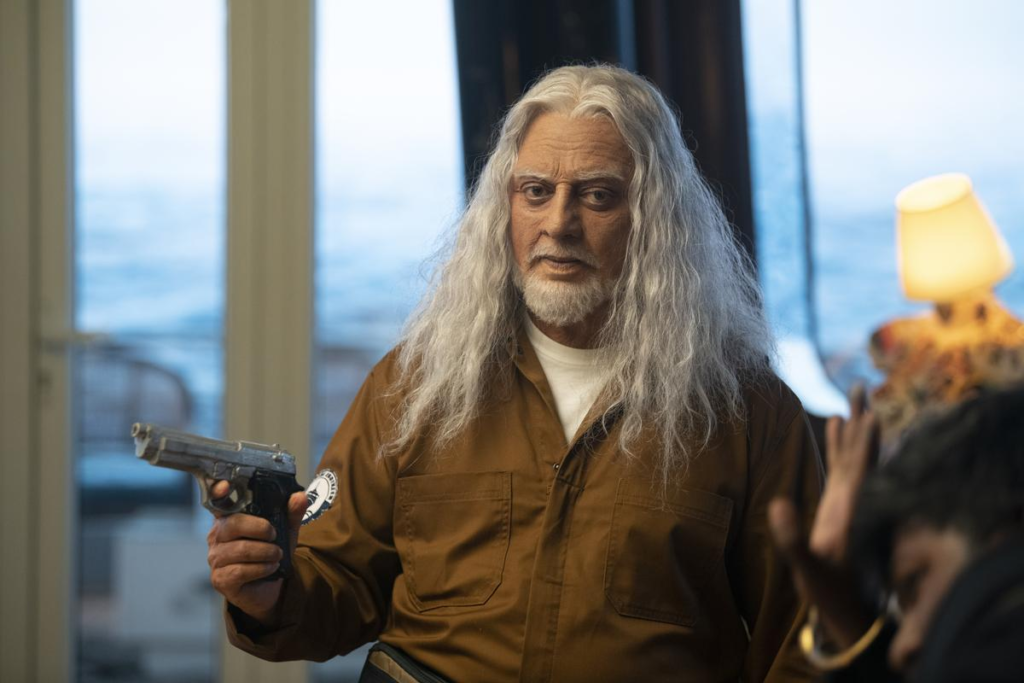Director: S. Shankar
Writers: S. Shankar, B. Jeyamohan, Kabilan Vairamuthu, Lakshmi Saravana Kumar
Stars: Kamal Haasan, Siddharth, Bobby Simha
Synopsis: Senapathy, an ex-freedom fighter turned vigilante who fights against corruption, returns to India to aid a young man who has been exposing corrupt politicians in the country through videos on the internet.
“Corruption causes cancer to the nation. Corruption kills.”
These words are spoken at the top of S. Shankar’s Indian 2 before any image is shown, setting the stage for Senapathy’s (Kamal Haasan) grand return to the screen twenty-eight years after the original Indian, which solidified Haasan’s star prowess within Tamil cinema. The film had a troubled production that lasted five years due to multiple delays attributed to the COVID-19 pandemic (two main actors passed away from COVID-related complications during filming), an accident that caused the death of three crew members, and Shankar taking on new directing responsibilities through his Telugu-language debut, Game Changer, starring RRR’s Ram Charan after Haasan signed on to star in Lokesh Kanagaraj’s Vikram while waiting for production on Indian 2 to resume.

The first Indian tackled the subject through Haasan’s dual performance as Chandrabose (“Chandru”), who has to face his father, Senapathy, after bribing his way to become a brake inspector, giving a safety certificate to a bus with defective brakes, which leads to the death of over 40 schoolchildren during a tragic accident. Chandru attempts to redeem himself, but Senapathy has been on a vengeance-fueled path of getting rid of Tamil Nadu’s corruption problem, with many high-ranking officials taking bribes from people who barely have anything to live by. This confrontation leads to a shocking climax, in which Senapathy kills Chandru for having bribed his way into not facing justice for his corruption before the vigilante perishes in a massive explosion.
Senapathy survived, mind you, and has been in exile ever since. Theoretically, he should be dead, with the first film set in 1996 and extended flashbacks in the second half revealing that he was a freedom fighter who upheld the ideologies of Subhas Chandra Bose during World War II. That means that, in Indian 2, he should be over 100 years old. The fact that he is not only in top physical form and can ride a Unibike without any problems at such an age will require you to suspend your disbelief. However, it’s the least of the film’s problems, which, in all honesty, doesn’t much matter since the prosthetics on Haasan’s face have always been hokey and look just as bad in this film as in Shankar’s Indian.
Senapathy is also a practitioner of the Tamil martial art Varma Kalai, which is real but has been stretched to inexplicable magic powers in the sequel. That could explain why he doesn’t look a day over 75, since many martial arts practitioners believe a daily routine slows down the aging process (especially when focusing on the meridian lines designed to heal the body). In the first film, Senapathy used these techniques to paralyze – and ultimately kill – his victims. By crossing his index and middle finger, Senapathy knew which points to hit on the body so their heart (or brain) would stop functioning. Shankar may be stretching the limitations of Varma Kalai a bit, but it’s nowhere near as far-fetched as in the second film, in which he presses a point to block a person’s blood from flowing and transforming them into…a girl…and a horse.
Yes, in the pre-intermission scene, one of Senapathy’s victims becomes a horse and rides off into the sunset until his body can’t take it anymore, collapses, and dies. Unlike many viewers who nitpick at everything when movies represent a romanticized world in which anything is possible, I can easily suspend my disbelief when a 100-year-old character rides a Unicycle and does perfect jumps with it. Shankar’s movies also require you to suspend your disbelief. It’s impossible to watch Enthiran – and its sequel, 2.0 – without distancing yourself from reality, as his visionary lens throws everything humanly possible to capture with eyes on the screen. That being said, I had a very difficult time doing so while watching someone become a horse in Indian 2, especially during a scene in which Senapathy confronts a horde of villains and transforms all of them into horses.

But the movie’s problems continued to add up, especially when Shankar returns to his anti-corruption cinema roots after a brief stint in the world of science fiction (with the Enthiran series), a remake of Rajkumar Hirani’s 3 Idiots, and a cross between The Hunchback of Notre Dame and Beauty and the Beast with 2015’s I. When you open your film with “Corruption causes cancer to the nation. Corruption kills.” (in replacement of the usual “Smoking kills” advert placed in front of every Indian movie with tobacco use involved), you’re forcing the picture to be unabashedly bold with its presentation of how corruption is not only a cancer to ourselves and the people we affect but the world. When it is riddled with corruption, the world becomes further diseased when opportunistic individuals take advantage of people in dire need of help.
The film’s thesis is worth exploring—and recontextualizing—in the era of social media, especially since Shankar hasn’t made an anti-corruption picture since his masterpiece, 2007’s Sivaji: The Boss, way before Facebook, X, and Instagram became a part of our everyday lives. And it’s from that framing device that a group of content creators, known as “The Barking Dogs,” who expose corruption through a series of satirical videos, demand Senapathy’s return after a young woman killed herself when a corrupt official framed her for fraud. With the hashtag #COMEBACKINDIAN, they created a worldwide movement for Senapathy to resume his vigilante activities in Tamil Nadu, as corruption has metastasized to even more dangerous heights.
Senapathy has been on his own quest for anti-corruption while in exile and disguises himself to avoid being caught by the Tamil Nadu Commando Force and its officer, Pramod Krishnaswamy (Bobby Simha), the son of the inspector (Nedumedi Venu), who was on Senapathy’s tail in the first film. When his presence is demanded back in India so he can end the rampant corruption plaguing the country, he returns and is lauded as a hero as he makes a Facebook livestream to instruct his followers on how to eliminate this fast-growing cancer, once and for all. But The Barking Dogs soon realize there is a price to pay on going after corrupt individuals, especially if they are members of your own family, and that’s when Shankar takes a rather emotionally manipulative direction with his story.
The film’s first half isn’t very interesting. Visually, it looks as grandiose as every Shankar film (with particular attention to detail given to a gold-laden safe where a corrupt individual likes to do his business on a gold-painted toilet), and there are a few sequences where Haasan goes all out in riveting monologues that rival the television studio scene in the first Indian. It also has a deeply problematic scene in which, to fool the cops at the airport, Senapathy disguises himself as a Chinese martial artist. Yes, Kamal Haasan in yellowface.
And I’ve just learned, through film critic Pramit Chatterjee, that the actor did the same thing in K.S. Ravikumar’s Dasavathaaram. Upon further research, and in the same film, he also donned blackface and played George W. Bush??? I’ve said this in previous reviews: I wouldn’t call myself the foremost expert in Indian cinema – I always have blindspots, even after seeing plenty of Kamal sir’s films. This does put the disguise in Indian 2 in a bit more context, but it is still deeply offensive and unacceptable, especially when so much progress has been made in our culture to confront the racist stereotypes of the past by positively representing different cultures through their artistic lens.

This disguise acts as a bad omen for the rest of the film, which becomes essentially a parallel montage between The Barking Dogs, who catch family members in the act of committing corruption, and Senapathy continuing his mission to kill as many high-ranking (corrupt) officials as possible. The movie then reaches an inflection point in its post-interval scene, in which the dogs’ leader, Chitra Aravindan (Siddharth), learns a drastic piece of news about one of his family members, and makes their life even harder by doing what he thinks is right. This is where the movie becomes downright cruel, and its exploration of how vigilante justice may also corrupt the soul never goes deep enough to mean anything, especially when this moment (and somewhat poignant exchange) between Chitra and Senapathy isn’t resolved.
Oh yeah, did I forget to mention that the sequel has been split into two parts after the rough cut assembled by editor A. Sreekar Prasad was over SIX HOURS LONG??? That’s crazy – even for Shankar. As a result, the 180-minute-long film has a dragged-out first half that sets up the return of Senapathy in a not-so-thrilling fashion and a second half that begins to ask questions on the relevance of ‘Indian’ coming back, only to abruptly end when the dramatic tension is at a maximum with an “I’ll be back” moment that’s more reminiscent of Skeletor’s post-credit scene in Gary Goddard’s Masters of the Universe instead of the T-800 in James Cameron’s The Terminator.
Before that, though, Shankar culminates his picture with a bravura chase sequence involving Senapathy riding a Unicycle as he tries to escape the commandos and the villagers who now want him to return to where he came from. The use of FPV drones, in particular, is a real show-stopper to witness in IMAX, especially when cinematographer Ravi Varman dizzyingly moves his camera to sync with the Unicycle zigzagging inside a train, a construction field, and a small marketplace. It proves that, no matter how shoddy his screenplays might have gotten, Shankar still has the juice to dazzle with his camera and create larger-than-life sequences that are indescribable in words but so eye-widening to soak in on a large canvas. His direction of musical numbers has also improved, with Anirudh Ravichander creating a soundtrack that celebrates the legacy of AR Rahman’s compositions with his modern spin on the material. “ZagaZaga” is a bop, and “Calendar Song” is also pretty damn great. It doesn’t reach the same heights as Anirudh’s previous works, Jawan and Lokesh Kanagaraj’s Leo, but it comes close to topping Rahman’s music in the first. Fight me.
Like Kevin Costner’s Horizon: An American Saga, Chapter 1 ended with a sizzle reel of Chapter 2, Shankar gives audiences a glimpse of what’s to come with Indian 3. Haasan even admitted in the press tour that he signed up to do Indian 2 only because he loved what he read for Indian 3. As soon as I saw an immaculately cathartic shot of two British soldiers decimated by an elephant with a pole, I didn’t need to see anything else. I’m in, no matter how dull this one was. The intense bursts of action give me hope that Shankar will create a mass spectacle that rivals some of his greatest productions.
But when he directly cites Sivaji: The Boss on multiple occasions in Indian 2, while never matching (or further modernizing) the potent anti-corruption study he drew in his 2007 masterpiece, it only makes me want to leave the cinema and spend three hours with Rajinikanth instead.
Go back, Indian.





